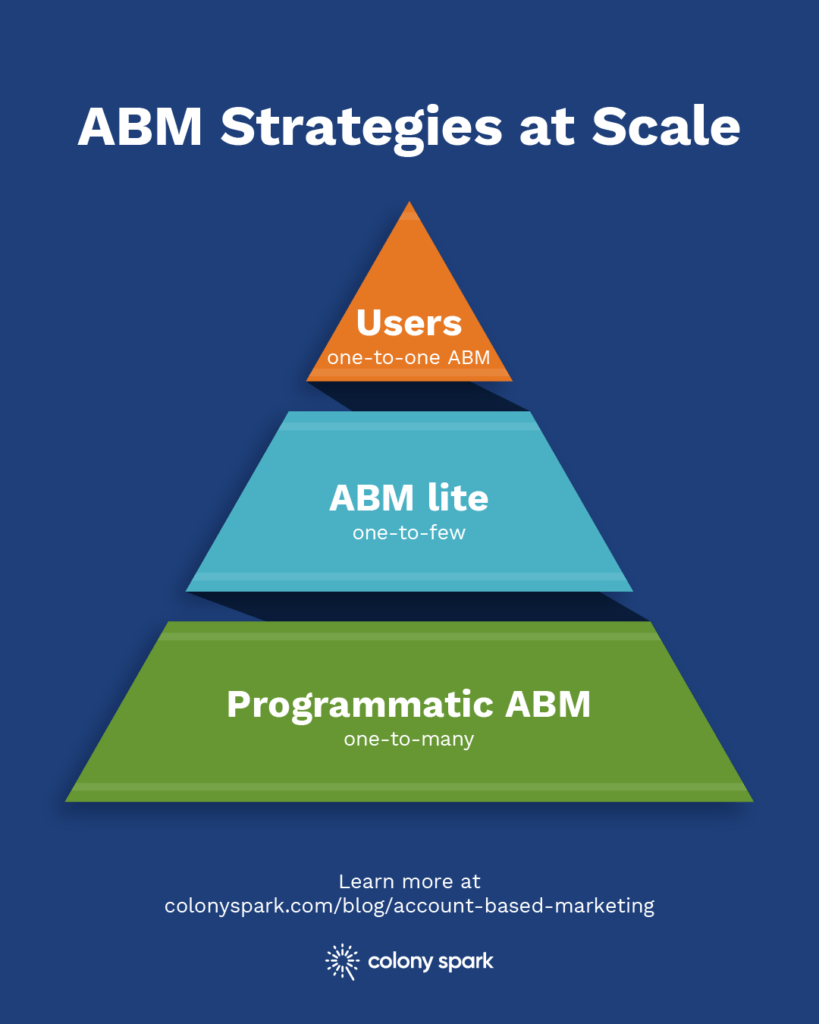Account Based Marketing or ABM is a focused approach based around an individual or a single business’ needs. It creates a personalized, ongoing marketing campaign, flipping the sales funnel by starting with identifying high-value accounts and building marketing and sales experiences around these customers. Doing ABM right results in better ROI and alignment of the sales, marketing, and key accounts teams. There are three main types of Account Based Marketing strategies a team can implement.
The first is strategic or one-to-one ABM, the next is ABM lite or one-to-few, and the last is programmatic ABM or one-to-many. Think of these three strategies as a pyramid; strategic is on top, followed by ABM lite, and then programmatic. The higher up on the pyramid, the more investment, and ROI. You might also employ a combination of these strategies, depending on your goals. Let us consider each approach and how a team might use these in B2B marketing.
Get a Free
Paid Media Analysis
Go beyond leads and understand the ROI of your paid advertising channels.
We’ll review your ad results and CRM to deliver an actionable
report with insights on how to grow more efficiently.
Get a Free
Custom Audience Report
Learn where your audience is to maximize your marketing investments.
Fill out the form below and we’ll be in touch with your report.

One-to-One Marketing: Strategic ABM
Strategic ABM is typically for existing high-value accounts. With this approach, the sales, marketing, and executive teams strengthen relationships with these customers to upsell and cross-sell products. When employing strategic ABM, teams create hyper-targeted account marketing plans for one to five accounts with identifiable, unique needs.
This approach requires the most resources, so marketers need to have a firm grasp of the customers’ needs. Running strategic ABM needs months, if not years of targeting, and businesses using one-to-one marketing typically measure ROI in years.
Everything from creating personas to conducting research should produce relevant, hyper-targeted messaging that will convert. When a team has a big budget, high-value existing clients, and time, tools, and people, one-to-one is the best B2B startup marketing strategy.
One-to-Few Marketing: ABM Lite
The next level is one-to-few marketing or ABM lite, where marketers target second-tier named accounts. ABM lite does not require as much focus on individual customers’ needs. Instead, the sales and marketing teams will identify five to ten target accounts with similar challenges, goals, and needs.
ABM lite is a good option for companies with flexible budgets and can add tools and team members. You would still need to thoroughly understand your ideal customer personas, profiles, and segments when creating these B2B account groups. Still, you have the option of creating highly targeted messaging for them.
Get a Free
Paid Media Analysis
Go beyond leads and understand the ROI of your paid advertising channels.
We’ll review your ad results and CRM to deliver an actionable
report with insights on how to grow more efficiently.
Get a Free
Custom Audience Report
Learn where your audience is to maximize your marketing investments.
Fill out the form below and we’ll be in touch with your report.

One-to-Many: Programmatic ABM
The third tier is one-to-many marketing or programmatic ABM. Like one-to-few marketing, programmatic ABM groups accounts according to their business needs, goals, and challenges. However, instead of focusing on five to ten accounts, programmatic ABM groups hundreds, even thousands of accounts using customer demographics.
Often, marketing teams successful in programmatic ABM use CRM software or a marketing automation tool like Hubspot, Marketo, or Pardot, allowing them to group accounts and target their messaging based on industry vertical or other broad descriptors.
Smaller companies that don’t have extensive budgets can start targeting accounts using programmatic ABM. It still uses personalization and puts the customer at the center of your sales and marketing, but it does not involve as much resources.
The most common way to do this is to upload your audience, using identifiers such as email or phone number. What you may not know is there are alternatives to Facebook and Google Ads if you want to do this.
To target the buying committee of all businesses that fit your ICP, an effective and targeted channel is LinkedIn Ads. You can do this through their ad manager or by uploading an audience using Company Name and URL OR a contact list you procured.
If you are casting a larger net or have access to personal emails of your target audience, programmatic CTV (such as Vibe) is an opportunity worth exploring. Here you’ll be able to target specific networks or use a familiar ad manager interface.
Conclusion
Getting buyers’ attention today looks very different from how it did only a few years ago. If marketers want to know how to advertise a startup business today, they must consider the new and evolving technologies and channels vying for people’s attention. Companies must find strategies that bring the most return on investment; for example, choosing one of these types of Account Based Marketing.
Whether strategic, lite, or programmatic, ABM lets businesses lean into relationship-building with their customers, serve them targeted messages, and create a truly personal brand experience.
Get a Free
Paid Media Analysis
Go beyond leads and understand the ROI of your paid advertising channels.
We’ll review your ad results and CRM to deliver an actionable
report with insights on how to grow more efficiently.
Get a Free
Custom Audience Report
Learn where your audience is to maximize your marketing investments.
Fill out the form below and we’ll be in touch with your report.




